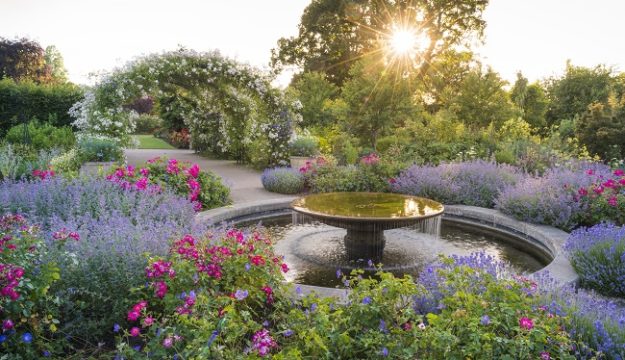 The Fountain in the Country Garden at RHS Garden Wisley is also a key part of any visit © RHS/ Joanna Kossak
The Fountain in the Country Garden at RHS Garden Wisley is also a key part of any visit © RHS/ Joanna Kossak
The Royal Horticultural Society (RHS) is to reinstate the forgotten history of horticultural icon Ellen Willmott, who spearheaded the charity’s acquisition of its flagship garden following what was a sometimes strained relationship.
In the first formal acknowledgement of Willmott’s influence in the RHS’s history and the acquisition of RHS Garden Wisley, the garden will officially open the Oakwood Summerhouse on April 10.
Willmott was a significant figure in horticulture at the turn of the 20th century, having co-sponsored many plant-collecting expeditions that introduced new species to cultivation, several of which were named for her. She created three extensive gardens across Europe, including Warley Place in Essex.
Willmott had been involved with the RHS for around 40 years until her death in 1934. However, her relationship with the charity, while always being intense, was rarely smooth. In 1897, she became the subject of disapproval for her mysterious no-show at the inauguration ceremony of the Victoria Medal of Honour, having been one of only two women to have been awarded the prize among 60 recipients.
The reasons for her absence were previously unknown, and she was long accused of snubbing the prestigious award. However, recent research suggests that Willmott was suffering heartbreak following the ending of an intense relationship with her friend, Gian Tufnell. Willmott appeared to have been genuinely “in love” with Gian, who went on to marry Lord George Mount Stephens in a ceremony taking place the day after the prize-giving, ensuring the horticulturist’s love remained unrequited. While she felt unable to admit the reason at the time, her absence was poorly regarded by the RHS.
Despite this, six years later, she went on to facilitate the society’s ownership of what would later become RHS Garden Wisley. Her friend, George Fergusson Wilson, had died in 1902, leaving behind a 13-acre “experimental garden” which had embraced the more modern “wild garden” movement, in contrast to the more formal gardening styles of the period.
Willmott, who had recognised it as a special place from her visits there, urged Sir Thomas Hanbury, a wealthy friend and creator of the garden at La Mortola, to purchase the land and gift it to the RHS, who had no available funds following the building of Horticultural Halls in Vincent Square and did not yet have a garden. Willmott was integral to its early development, donating numerous plants to the Rock Garden and acting as RHS Wisley’s first garden trustee. The garden has since grown to become one of the world’s greatest and has come to symbolise the RHS’s horticultural excellence.
News of Willmott’s role in developing RHS Garden Wisley only emerged through research by Sandra Lawrence, author of Miss Willmott’s Ghosts: The Extraordinary Life and Gardens of a Forgotten Genius (Blink, 2022). Matthew Pottage, Curator of RHS Garden Wisley, was recording an episode of BBC Radio 4’s Gardeners’ Question Time at Warley Place soon after the book’s release and the story emerged.
As he considered how best to acknowledge Willmott, RHS Fellow Patricia Smith, who had also heard the BBC Gardeners’ Question Time episode, approached Pottage and suggested a tribute to the trailblazing gardener. Willmott was a fan of summer houses, with no less than eight at Warley Place alone. So, it was decided that one should be built to recognise her role in Oakwood, the historic, original part of RHS Garden Wisley that Willmott would have remembered.
Funded by Smith, the Oakwood Summerhouse has been constructed by Surrey Oak Barns and features interpretation boards describing Willmott’s role and the history of how the area came to become RHS Garden Wisley. The boards also highlight the other recipient of the VMH in 1897—Gertrude Jekyll, a similarly towering figure in the history of horticulture.
Pottage said: “For decades, Ellen Willmott was only known for scattering sea holly seeds in unwanted places and being cantankerous. It is time to properly acknowledge this horticultural heavyweight’s drive, vision, and abilities.
“Enormous thanks must go to Sandra Lawrence for bringing this evidence to the attention of the RHS, and of course, Patricia Smith for making this beautiful new summerhouse possible.’’
For further information, visit rhs.org.uk/wisley





